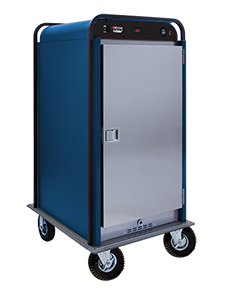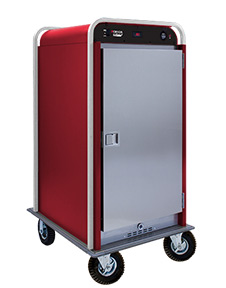It’s becoming clearer that the COVID-19 crisis will leave a lasting impact on the foodservice industry. Even if and when a vaccine is discovered, sanitation and hygiene norms have likely been forever changed. We believe it’s safe to assume a subset of foodservice customers will continue to seek out and recognize establishments capable of minimizing direct human contact in an effort to protect themselves and their families.
And thus is born a surge in contactless foodservice technology. Here are a few innovative products and ideas that can help the foodservice industry prepare for the new normal. Some are noteworthy applications of existing products. Some are a clever repurposing of existing products with modifications. And some are completely new and groundbreaking.
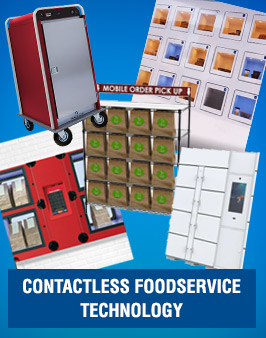
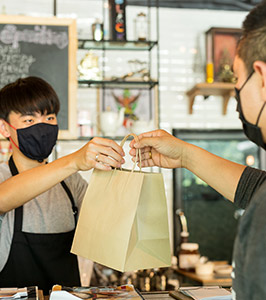
What Does the Future Hold?
Trends indicate that takeout and delivery will continue to become more prevalent in ALL foodservice operations. Businesses that may have only had 3 or 4 takeout orders a day should anticipate this service to become as much as 20% of all orders going forward. And this isn’t going to just apply to restaurants. We anticipate a take-out and delivery method will be expected in business and industrial cafeterias, hospital cafeterias, and possibly even senior living and schools (from K-12 all the way through colleges and universities).
Delivery and takeout stations as outlined in our article The Off-Premise Dining Trend should be considered, if not already implemented in your establishment. In that article we highlighted a few basic pieces to help set up your stations, while this article is focused on some newer pieces that may also be useful for a contactless experience. But first…
Why Use a Contactless Staging Station Going Forward?
It’s still unclear how long the most recent COVID-19 pandemic is going to last. Dr. Fauci has been quoted as saying we could be looking at this battle for next year and a half! Consider the impact on our social psyche and consumer confidence that two full years of virus anxiety will bring. Likely, we’ll be more attentive to our surroundings and the sanitation practices we observe.
Having a designated area for contactless order pickup helps in two main areas of customer perception.
- A clear contactless path for customers to obtain their takeout meals or drivers to obtain their delivery orders with minimal need of staff intervention allows your customers to get in and get out quickly using a safe and efficient dedicated area.
- This in turn will increase dining room customer confidence in that there are limited external exposure opportunities. Those dining in will see that “not everybody is going up to the bar” or engaging with the host/hostess and other staff. FOH staff is dedicated the protection and service of the dining room patrons only.
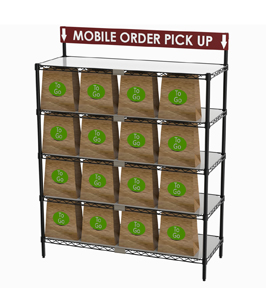
What Should Your Staging Station Look Like?
Clearly, this will depend on your operation and your volume, but in all cases it should be highly visible. Use clear signage with large print for directions of use and order identification. Avoid forcing customers to handle each order to squint at the receipt to determine ownership. Use a numbered grid to identify staging areas and communicate in which “slot” their order can be found. Stations can be as simple as the CR2430DSS to-go stands and CR1824GSR cart units from Metro. They are just basic shelving units and mobile carts with clear signage that can be placed pretty much anywhere. They are also very inexpensive, perfect for a “mom & pop” type restaurant or café.
Contactless Food Lockers
For very high-volume establishments, or in areas (like hospitals and senior care facilities) where there may be an increased likelihood of customers and personnel with respiratory issues or compromised immunities, a more robust solution may be required. For these challenges, we’ve seen an influx of food lockers.
Food lockers are basically a system of isolated compartments that may hold ambient, hot, or cold temperatures for customer/driver pickup. More advanced models may even offer dual temperature options, pass-thru doors, or activation/unlocking by in-app QR code scanning configured with your POS system.
The ideal scenario for a food locker system may be as follows:
- A consumer places their order through your website from their office for a salad, hot roast beef sandwich, chips, apple, cookie, and milk. They receive an order confirmation email.
- The order is received through your POS system and prints off in your kitchen for production.
- Kitchen staff insert the salad and milk in a cold locker and assign that locker to the order. They also insert the chips, apple, and cookie in an ambient locker and assign that locker to the order too. Lastly, after the hot roast beef is finished cooking, it is placed in a container in a hot temp locker which is assigned to the order as well.
- The customer receives confirmation the order is ready with a QR code.
- Customer approaches the locker and scans their QR code at the terminal. All lockers with contents belonging to the order are identified and unlocked, allowing the customer to retrieve their meal at proper serving temperatures with zero human contact.
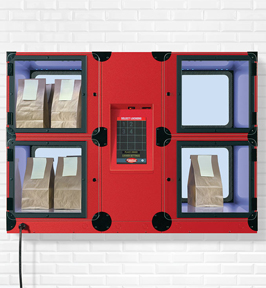
Hatco FLAV-R 2-GO Food Lockers
Hatco’s FLAV-R 2-GO food locker system is one of the more basic versions and is available at a friendlier introductory price point. This system allows for Hot and Ambient temps only.
Each locker features a timer to hold packaged foods for up to 45 minutes and is preset at 150ºF (66ºC), with a high temperature range up to 200ºF (93ºC). The heat can be turned off for ambient food holding.
Though it comes standard with manual operation, POS integration capabilities are available with outside vendor setup.
They are available with pass-through or one-sided access. On pass-through models, the customer side stays locked until the customer enters their access code – LED lights will then flash in the appropriate locker and the door will unlock.
Atosa Intelligent Food Safe Lockers
Atosa will be introducing a series of contactless Intelligent Food Safe Lockers that will come in three primary variations. All offerings will be for 8 door units. One configuration includes only ambient temp holding. Another will offer ambient, warming, and refrigerated. A third will offer refrigerated and freezer.
Standard on all versions will be a 21.5” touch screen control panel with a QR code scanner and surrounding dry storage areas. Unique to these units is a patented “Hybrid Cooling Technology” and temperature detection.
These units can be used indoors and outdoors when placed under a canopy. Freezer compartments hold from -7.6ºF to 1.5ºF. Refrigerated mode holds temperatures from 34ºF-43ºF. Ambient compartments from 41ºF-77ºF. In heated mode, all lockers within each section must remain one temperature, with a range from 140ºF-160ºF.
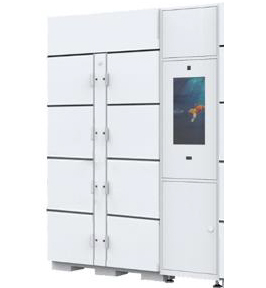
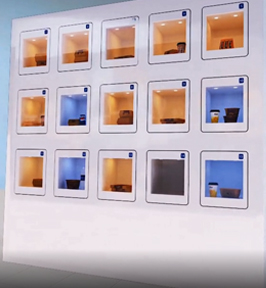
RPI Industries Ondo Food Wall
On the higher end of technology and innovation is the ONDO wall, featuring the latest technology with order and prepay through a mobile app or a stationary ordering kiosk. It is available with rear or front loading, where the system software selects the appropriate cube that can be hot, cool, or ambient.
Patented technology for hot/cold convertible compartments offers a temperature range from 36ºF-190ºF for hours of fresh holding. A key component of the ONDO system is a commitment from RPI in service, installation, and one-on-one training with ongoing technical support.
The automated processing system uses intelligent software to direct the operator to the placement that’s most efficient for each meal. The system constantly updates to track the occupied and vacant spaces, and automation simplifies the customer notification process.
Data analytics provide valuable insight, including sales per time of day, holding times, and more to better prepare your staff for future events.
Pass Thru Warming Stations and Heated Transportation through Office Spaces
In cases where food lockers may not be in the budget, a compromise that has been discovered by our team is to utilize simple “pass thru” heated food warmers. Their use prevents frontline FOH personnel from diverting their attention from on-site diners to facilitate the increase in takeout, pick-up, and delivery services traffic.
In a busy quick-serve shop located in a downtown business district skyway, a quick solution to address this was to actually cut an additional hole in the wall separating the kitchen space and the customer area and install a pass thru slanted heated merchandiser. With this simple solution, business folk can order online from their desks in offices connected to the skywalk, then simply walk over and retrieve their order directly from the kitchen, freeing up the service staff to take foot traffic orders and maintain greater social distancing in their lines.
Crescor Hot Holding Cabinets like the Hotcube, Coldcube, and Firecube are also being considered in some cases to bring contactless temperature controlled meals to these reopening office spaces. Several of these units can utilize solar and compact propane to hold temps on location AND their skins allow for easy branding. Imagine the smell of delectable Indian cuisine wafting down the hallways, followed by a branded cart of deliciousness rolling past with a call to action to order now for deskside delivery. A brilliant marketing strategy if nothing else. As an added bonus, these units are multi-functional in that you can use them in the morning for rethermalizing, then for roasting and prep prior to use in your delivery system, while also boosting brand awareness in the local area. Win, win, win, win.
